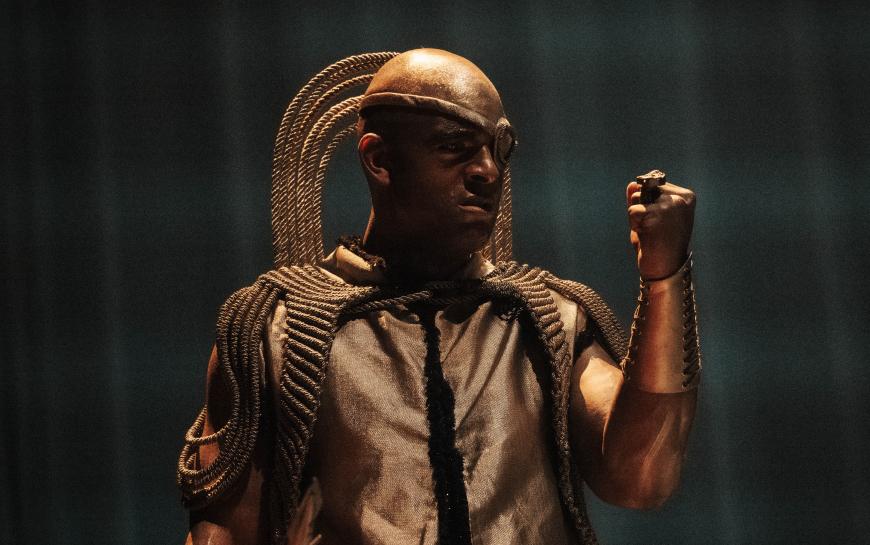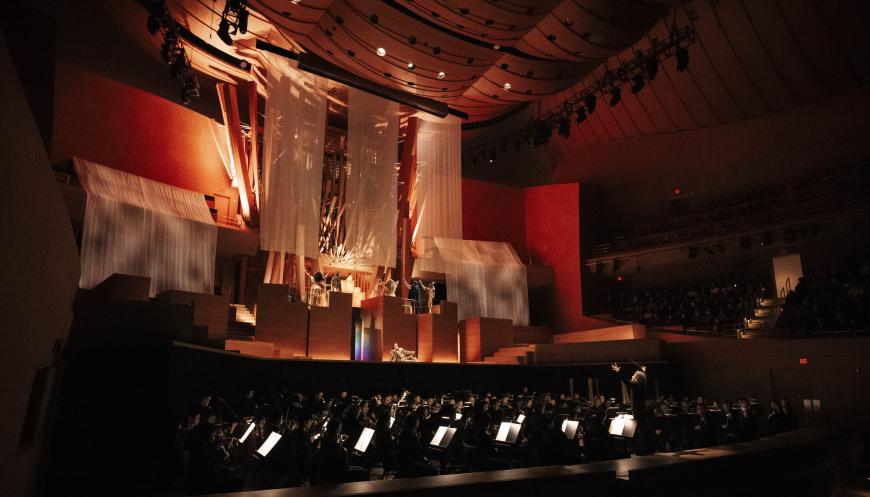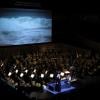
From the moment 20 years ago when the first notes sounded at Walt Disney Concert Hall — a partita by J.S. Bach played from the organ loft, with Charles Ives’s The Unanswered Question resounding from the rafters — conductors, theater directors, choreographers, visual artists, and scenic, costume, and lighting designers have all embraced the challenge of completely utilizing Frank Gehry’s landmark venue.
It’s a two-decade tradition that was celebrated Saturday with a fully staged production of Richard Wagner’s Das Rheingold that featured a stellar international cast of singers and the Los Angeles Philharmonic at full Wagnerian strength under Gustavo Dudamel, with sets designed by Gehry and vivid costumes by Cindy Figueroa, all enhanced by a rainbow’s worth of projections and lighting effects by award-winning cinematographer Rodrigo Prieto. The insightful overall direction was by Alberto Arvelo, with skilled supertitles by the production’s dramaturg, Cori Ellison.

Presenting opera in Disney Hall isn’t a question of form following function. Operas have to be fitted to the space. A diverse roster of talent has taken up the challenge: Esa-Pekka Salonen, Peter Sellars, and visual artist Bill Viola, who first presented opera in the hall with The Tristan Project; Dudamel and Gehry, who staged Mozart’s three Da Ponte operas; Yuval Sharon, who mounted War of the Worlds and Lou Harrison’s Young Caesar; Elkhanah Pulitzer, who presented John Adams’s Nixon in China; and the teams that took on Meredith Monk’s Atlas and, most recently, the six hours of Dylan Mattingly’s Stranger Love.
For Das Rheingold, to represent the aquatic realm of the Rhinemaidens, the lofty residence of the gods, and the subterranean caverns of Nibelheim, Gehry conceived a series of towering wooden platforms of varying heights, connected by stairways that seemed to grow organically out of the back of the stage.
The vast orchestra (including an expanded brass section and the six harps Wagner asked for in the score) filled the stage, with a connecting walkway between the audience and the orchestra that provided needed flexibility to the staging and closer proximity for the singers.

Appropriate for the depths of the Rhine, the performance emerged out of total darkness, with Dudamel already at the podium. Gradually, Wagner’s shadowy currents beginning in the low strings gave way to glittering rays of brass fanfare as soprano Ann Toomey (Woglinde), soprano Alexandria Shiner (Wellgunde), and mezzo-soprano Taylor Raven (Flosshilde) made their entrances, frolicking and glittering in harmonious splendor.
Crazed by their beauty, baritone Jochen Schmeckenbecher, as a toad-like Alberich, vied for their affection. The Rhinemaidens’ taunts, trickery, and rejections, however, combined with the revelation of the Rhinegold, led to the love-renouncing vow and theft that sets Wagner’s four-opera Ring of the Nibelung in motion.
Led by the resounding voices of bass-baritone Ryan Speedo Green as Wotan and mezzo-soprano Raehann Bryce-Davis as his equally commanding wife, Fricka, the gods awoke from their slumber to discover that the payment for their disastrously financed new home, Valhalla, was due on delivery. The twin giants Fafner (bass Peixin Chen) and Fasolt (bass Morris Robinson) demanded their fee in the form of Freia (soprano Jessica Faselt), keeper of the golden fruit that provides the gods with eternal life.

Desperate for an alternative solution, Wotan summoned the trickster demigod Loge (tenor Simon O’Neill), who observed the theft of the Rhinegold and Alberich’s rise to power. To forestall the giants, Wotan and Loge planned to descend to Nibelheim to capture their enemy’s treasure. For the journey to the center of the earth, Dudamel and the orchestra produced cavernous effects accented by twin batteries of anvil-like percussion, which clanged from the upper reaches of the hall.
With Alberich tricked, captured, and robbed, the debt was paid. But the dwarf had put a curse on the ring that he forged from the Rhinegold, prompting the all-seeing earth goddess Erda (mezzo-soprano Tamara Mumford) to warn Wotan to give it up as she woefully forecast the end of the gods. Completing the cast were tenor Barry Banks as the downtrodden dwarf Mime, bass-baritone Kyle Albertson as the hammer-wielding Donner, and tenor John Matthew Myers as Freia’s hot-tempered brother, Froh.
Spectacular in its musicianship and theatrical impact, this was a Rheingold that truly fulfilled Wagner’s concept of a total musical-theatrical experience. This was luxury casting worthy of the best opera houses. The direction and visualization were adept, while Dudamel led a performance that captured the overarching grandeur as well as the myriad instrumental and vocal details of the score.
Throughout the performance, Prieto (who has just been nominated for an Academy Award for his cinematography for Killers of the Flower Moon) provided atmospheric lighting effects, like the remarkably realistic Rainbow Bridge, and film sequences, like the abstract image of a giant coiling snake to represent Alberich’s magical transformation. His contributions played a crucial role in the production and fused perfectly with Gehry’s architectural set pieces.
It’s remarkable that the Phil is consistently willing to commit the resources to produce productions at this level for so few performances. It would be nice to think a complete Ring cycle could be in the orchestra’s future. The concept is too good not to see all the way through, and it would be wonderful to watch this cast take the full journey with their characters.




